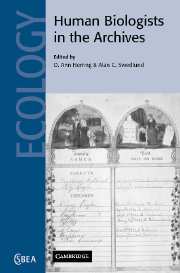 Human Biologists in the Archives
Human Biologists in the Archives Book contents
- Frontmatter
- Contents
- Contributors
- Foreword by Sydel Silverman and Michael A. Little
- Acknowledgements
- 1 Human biologists in the archives: demography, health, nutrition and genetics in historical populations
- 2 The use of archives in the study of microevolution: changing demography and epidemiology in Escazú, Costa Rica
- 3 Anthropometric data and population history
- 4 For everything there is a season: Chumash Indian births, marriages, and deaths at the Alta California missions
- 5 Children of the poor: infant mortality in the Erie County Almshouse during the mid nineteenth century
- 6 Worked to the bone: the biomechanical consequences of ‘labor therapy’ at a nineteenth century asylum
- 7 Monitored growth: anthropometrics and health history records at a private New England middle school, 1935–1960
- 8 Scarlet fever epidemics of the nineteenth century: a case of evolved pathogenic virulence?
- 9 The ecology of a health crisis: Gibraltar and the 1865 cholera epidemic
- 10 War and population composition in Åland, Finland
- 11 Infectious diseases in the historical archives: a modeling approach
- 12 Where were the women?
- 13 Malnutrition among northern peoples of Canada in the 1940s: an ecological and economic disaster
- 14 Archival research in physical anthropology
- Index
- References
5 - Children of the poor: infant mortality in the Erie County Almshouse during the mid nineteenth century
Published online by Cambridge University Press: 12 August 2009
- Frontmatter
- Contents
- Contributors
- Foreword by Sydel Silverman and Michael A. Little
- Acknowledgements
- 1 Human biologists in the archives: demography, health, nutrition and genetics in historical populations
- 2 The use of archives in the study of microevolution: changing demography and epidemiology in Escazú, Costa Rica
- 3 Anthropometric data and population history
- 4 For everything there is a season: Chumash Indian births, marriages, and deaths at the Alta California missions
- 5 Children of the poor: infant mortality in the Erie County Almshouse during the mid nineteenth century
- 6 Worked to the bone: the biomechanical consequences of ‘labor therapy’ at a nineteenth century asylum
- 7 Monitored growth: anthropometrics and health history records at a private New England middle school, 1935–1960
- 8 Scarlet fever epidemics of the nineteenth century: a case of evolved pathogenic virulence?
- 9 The ecology of a health crisis: Gibraltar and the 1865 cholera epidemic
- 10 War and population composition in Åland, Finland
- 11 Infectious diseases in the historical archives: a modeling approach
- 12 Where were the women?
- 13 Malnutrition among northern peoples of Canada in the 1940s: an ecological and economic disaster
- 14 Archival research in physical anthropology
- Index
- References
Summary
Introduction
Katz (1995) suggests that the purpose of poor relief historically was to prevent death from starvation, disease, homelessness, and lack of clothing. Thus the growing number of destitute people in the United States at the beginning of the nineteenth century prompted the establishment of almshouses to provide relief. These institutions were intended to isolate individuals from the corrupting influences of the outside world that were alleged to lead to a life of laziness, alcohol abuse and, ultimately, pauperism (Katz 1983, 1986, 1995). The failure of the almshouse system to provide for its inmates is well documented (Katz 1983, 1986, 1995; Lawrence 1976; Leiby 1978; Rothman 1971). Almshouses were overcrowded with immigrants who spent their last pennies on passage to America, arriving destitute and often sick. Inmates frequently endured appalling living conditions, inadequate food and exposure to infectious diseases. The almshouses in New York State exemplify these deficiencies. Inspections in 1856 indicated that living conditions in many of the State's institutions were ‘ … badly constructed, ill-arranged, ill-warmed and ill-ventilated’ (New York State Senate Report of 1857, in Katz 1986). Mortality records from the Monroe County Almshouse in Rochester, New York, also suggest that these institutions were pesthouses, where many people who were suffering from infectious diseases came to die (Higgins et al. 2002; Higgins and Sirianni 1995; Lanphear 1986; Sirianni and Higgins 1995).
- Type
- Chapter
- Information
- Human Biologists in the ArchivesDemography, Health, Nutrition and Genetics in Historical Populations, pp. 78 - 95Publisher: Cambridge University PressPrint publication year: 2002


